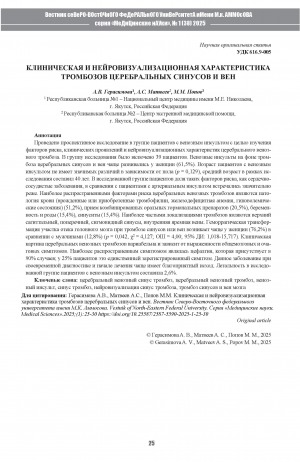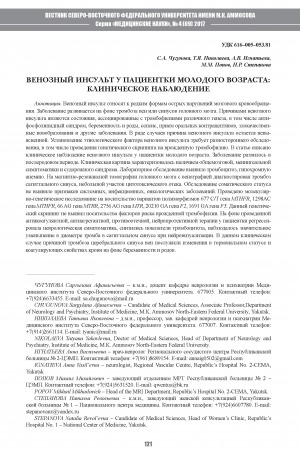Место работы автора, адрес/электронная почта: Республиканская больница N 2 - Центр экстренной медицинской помощи ; 677005, г. Якутск, ул. П. Алексеева, 83 "А" ; e-mail: qwentus@bk.ru ; http://rb2cemp.ru/
Область научных интересов: Медицина
Количество страниц: 6 с.
A prospective study was conducted in a group of patients with venous stroke to investigate the risk factors, clinical manifestations, and neuroimaging characteristics of cerebral venous thrombosis (CVT). The study covered 39 patients. Venous strokes due to thrombosis of cerebral sinuses and veins were more frequently observed in women (61.5%). There were no significant differences in the age of patients with venous stroke based on gender (p = 0.129), with a mean age of 40 years within the study cohort. In the investigated group, the prevalence of risk factors such as cardiovascular diseases was significantly lower compared to patients with arterial stroke. The most common risk factors for cerebral venous thrombosis included hematological disorders(congenital or acquired thrombophilias, iron deficiency anemia, hypovolemic states) (51.2%), the use of combinedoral hormonal contraceptives (20.5%), pregnancy and childbirth (15.4%), and sinusitis (15.4%). The mostfrequent sites of thrombosis were the superior sagittal sinus, transverse sinus, sigmoid sinus, and internal jugularveins. Hemorrhagic transformation of the brain edema at the site of sinus or venous thrombosis occurred more frequently in women (76.2%) compared to men (12.8%) (p = 0.042, χ2 = 4.127; OR = 4.00; 95% CI: 1.018-15.717). The clinical picture of cerebral venous thrombosis is variable and depends on the severity of generalized and focal symptoms. The most common symptom reported was cephalalgia, present in 90% of the cases; in 25% of the patients, it was the only registered symptom. This condition has a favorable outcome with timely diagnosis and initiation of treatment. The mortality rate in the studied group of the patients with venousstroke was 2.6%.
Герасимова, А. В. Клиническая и нейровизуализационная характеристика тромбозов церебральных синусов ивен / А. В. Герасимова, А. С. Матвеев, М. М. Попов ; Республиканская больница N 1 – Национальный центр медицины им. М. Е. Николаева, Республиканская больница N 2 - Центр экстренной медицинской помощи" // Вестник Северо-Восточного федерального университета им. М. К. Аммосова. Серия "Медицинские науки". - 2025. - N 1 (38). - C. 25-30. - DOI: 10.25587/2587-5590-2025-1-25-30
DOI: 10.25587/2587-5590-2025-1-25-30
Количество страниц: 6 с.
Venous stroke is one of the rare forms of acute cerebral circulation disorders. The disease develops due to the thrombosis of the brain veins or sinuses. The venous stroke causes are conditions associated with thrombophilia including the antiphospholipid syndrome, pregnancy, sepsis, oral contraceptive use, malignant neoplasms and other diseases. In some cases, the venous stroke cause remains unclarified. The venous stroke etiological factor establishing requires a multifaceted examination, including genetic screening for congenital thrombophilia. This article presents the clinical case of the venous stroke in a young patient. The disease developed in the postpartum period. The clinical manifestations were characterized by the presence of cerebral, meningeal symptoms and convulsive syndrome. The laboratory examination revealed thrombocytosis, hypochromic anemia. The brain magnetic resonance imaging with venography diagnosed the sagittal sinus thrombosis and small area of cytotoxic edema. Examination of somatic status did not reveal the signs of systemic, infectious, oncological diseases. The genetic study was carried out to identify the polymorphism variants, including 677 C / T of MTHFR gene, 1298AC of MTHFR gene, 66 AG of MTRR gene, 2756 AG of MTR gene, 20210 GA of F2 gene, 1691 GA of F5 gene. This genetic screening did not reveal the risk factors for congenital thrombophilia. We carried out the anticoagulant, antiplatelet, anti-edematous, neuroprotective therapy, and the neurological symptoms were regressed, thrombocytosis index decreased, the diameter of the sagittal sinus thrombus decreased. In this clinical case, the cerebral sinus thrombosis developed due to the changes in the hormonal status and blood coagulation properties on the background of pregnancy and childbirth. In clinical practice, it is necessary to pay special attention to the possible risks of cerebral sinuses and veins thrombosis during pregnancy and postpartum period. In addition, it is necessary to examine the carriage of genetic congenital thrombophilia risk factors in young venous stroke patients
Венозный инсульт у пациентки молодого возраста: клиническое наблюдение / С. А. Чугунова, Т. Я. Николаева, А. В. Игнатьева [и другие] // Вестник Северо-Восточного федерального университета им. М. К. Аммосова. Серия: Медицинские науки.— 2017. — N 4 (09). — С. 121-125.

